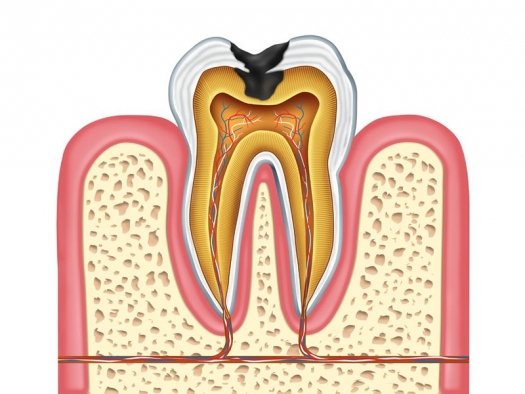Even a peek at the early days of nutrition research makes one fact plain: In many cases, disease is not so much the result of attack by germs but rather the inability of the body to resist such attack. And the chief determining factor of this resistance is one's nutritional status.
Just as this basic truth applies for the person who rarely gets the sniffles, so it goes for folks who avoid the drill at the dentist's office. "Diseases of the teeth," wrote Dr. John Gunther, "are related primarily to deficient food factors which predispose the dental tissues to invasion by microorganisms." Gunther, both a physician and a dentist, wrote these words in a 1942 article titled Nutritional Aspect of Dental Disease in the journal Philadelphia Medicine.
By contrast, some will say – and by some we mean mainstream modern dentistry – that cavities are merely caused by excessive sugary and starchy foods on the teeth. Bacteria convert these famous culprits into acids, which then attack and degrade the teeth's enamel and underlying tissues.
Yet if the mere presence of sticky carbohydrates dooms teeth, Gunther wonders, why, then, did a study show that children in New York regularly experience more cavities in late winter and spring than in summer and fall? It's unlikely that the consumption of starchy and sugary foods follows such a seasonal pattern.
Something that does follow such a pattern in New York, on the other hand, is the availability of the type of sunlight necessary for the body to make vitamin D, a key player in the maintenance of human teeth. (New York, because of its northern latitude, does not receive the proper frequency of sunlight for vitamin D formation for several months during the winter and early spring.)
Gunther also cites studies linking vitamin A deficiency with insufficient enamel formation and even small deficiencies of vitamin C with impaired function of tooth-forming cells. He notes as well that decreased consumption of minerals such as calcium and phosphorus, both basic components of teeth, is associated with increased rates of cavities. Malnutrition and tooth decay, he argues, simply go hand in hand.
The Lesson of Africa
One researcher who would have agreed wholeheartedly with Gunther is the famous Cleveland dentist Dr. Weston Price, who traveled the world in the 1930s specifically to find and study societies free of tooth decay. (Price was unable to find any such communities in the United States.)
What Price discovered was pretty simple. While cavities were ubiquitous and rampant in every society that had adopted industrially processed foods, those populations that had stuck with their traditional diets were virtually free of the disease. And, while the diet of these cavity-free cultures varied tremendously – from the mostly-meat-eating Eskimos of Alaska to the hardy rye-and-dairy villages of the Swiss Alps – one place proved particularly illuminating in our cavity debate: Africa.
Price studied nearly 30 tribes of the central African plains, many of them subsisting on a starchy agricultural diet comprising sweet potatoes, beans, cereal grains, and the like. Uninitiated to toothpaste or dental floss, the mouths of these people were completely "smeared with starch," as he put it.
With the enzyme salivary amylase breaking down a portion of that starch into sugar, the bacteria in the Africans' mouths had the ideal environment to do their stuff. These natives, according to the conventional theory of cavity formation, should have been riddled with tooth decay. Yet their cavity rates were astoundingly low – in the range of 1 to 2 per one hundred teeth.
Furthermore, in those tribal Africans who'd begun to replace the foods of their traditional diets with processed ones – and all the nutrient deficiency that comes with them – the cavity rate was 20 to 30 cavities per hundred, a figure more in line with industrialized nations.
Fill Your Own Cavities?
Another "fact" touted by modern dentistry is that tooth decay is irreversible. Once a cavity starts, it will continue to grow until the tooth's nerve endings are exposed and all hell breaks loose. The best one can do, therefore, is stop a cavity in its tracks, or "drill it and fill it," as they say.
Yet in 1924, Dr. May Mellanby – wife of vitamin-D discover Edward Mellanby and respected scientist in her own right – conducted an experiment that turns this notion on its head, at least for cavities in the early stages of formation. By supplementing the diet of a group of children suffering early-stage tooth decay with a hefty dose of vitamin D3, Mellanby was able to not just stop cavities from forming but actually reverse them.
Interestingly, Mellanby did not have the children cut down on their sweets. They continued to eat "sugar, jam, and syrup" and hot chocolate as well as starchy bread and oatmeal (along with whole foods such as milk, butter, eggs, meat, and vegetables). Yet, over six months, the children on average formed only one new cavity while healing four.
A quasi-control group, which was given the same diet except without the supplemental vitamin D and with some extra oatmeal, went on to develop almost six cavities apiece while healing virtually none.
An Anti-Cavity Diet
Based on the works of Drs. Price and Mellanby, Dr. Stephan Guyenet, nutrition researcher and author of the acclaimed blog Whole Health Source describes the ultimate cavity-healing (or preventing) diet as "rich in animal foods, particularly full-fat, pastured dairy products, [as well as] meat, organs, fish, bone broths, and eggs."
Other good foods, he says, include raw vegetables and cooked starchy vegetables such as potatoes and sweet potatoes with lots of pastured butter, and fruit, though he recommends limiting that to one piece a day.
Grains, if eaten, he warns, must be prepared carefully because of their high content of phytic acid, which blocks the absorption of critical tooth-building minerals such as calcium. Grain foods that are unfermented, such as oatmeal, breakfast cereal, crackers, etc., should be strictly avoided.*
He also advises plenty of vitamin D, either through sunlight exposure, high-vitamin cod liver oil, or a vitamin D3 supplement. And, of course, no industrially processed foods.
Nourish, Brush, Smile
In his article, Dr. Gunther does not deny that cavities are formed as the result of bacterial action in the mouth. The question is, why does the "attack" of the bacterial waste products succeed?
Microbes are all around us, all the time – in our mouth, our gut, our eyes, our lungs, etc. What decides whether they make trouble for us? Is it chance? Or is it the difference largely a matter of our ability to withstand attacks by such organisms? It seemed clear to Dr. Gunther, as it did to most early nutrition researchers, that health has more to do with properly fortifying the body than wiping out would be antagonists.
This doesn't mean, when it comes to our teeth, that we should eschew measures to reduce the number of acid-producing bacteria in our mouth. Brushing and flossing are certainly an excellent adjunct to tooth care, but all the cleaning in the world will not help our teeth if we're using them to chew lame foods.
References
*The best method of preparing grains, Dr. Guyenet says, is to sour ferment them prior to cooking, a process that thoroughly breaks down their phytic acid. Soaking and sprouting, other common preparations, are only partially effective in degrading the mineral inhibitor, and for grains that have been previously heat treated, such as oats, soaking does not reduce phytic acid content at all, making regular oatmeal consumption a suspect behind much tooth decay.
Originally published in Milk and Honey, a newsletter from Selene River Press; ©2012 Selene River Press, Inc. Used with permission.



